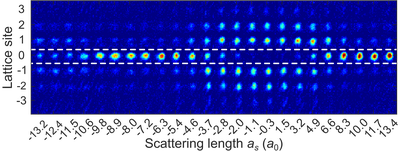Lattice solitons of matter waves.

Motivation
Solitons are one of the paradigmatic effects of nonlinear sciences. They are dispersionless waves that travel without changing shape and have been observed in many disciplines such as optics, fluids and biological systems. In quantum gases they form due to a balance between the kinetic term in the Gross-Pitaevskii equation and interatomic attractive interactions. Discrete solitons are solitons which form in the presence of periodic potentials such as lattices, due to this they have been heavily predicted to show unique condensed matter phenomena related to their motion and formation.

Challenges and approach
Soliton stability depends heavily on their density profile and as such in the presence of an optical lattice this creates the need to have strong control over the number of atoms occupying individual lattice sites. Furthermore, lattice solitons are also sensitive to the lattice depth and spacing with small changes in either producing solitons of varying sizes or no solitons at all. To overcome these challenges, we employ an optical accordion lattice, in which the lattice spacing can be tuned by adjusting the angle between the interfering laser beams (more detail). We dynamically vary the spacing from an initially small value, used to study the intrinsic properties of the solitons, to a much larger value at the end of the experiment, enabling magnification and precise measurement of the soliton’s density profile.
Results
Lattice solitons can be classified as single-site or multi-site depending on whether they occupy one or multiple lattice sites, respectively. We first investigated single-site solitons by preparing a single lattice site containing approximately 1000 atoms. After removing the trapping potential and quenching the scattering length, we observed the formation of solitons for weak attractive interactions. Interestingly, for strongly repulsive interactions, we also observed the emergence of a localized wave packet. These so-called “repulsive solitons” are related to repulsively bound pairs that appear in the single-atom regime.

Fig. 1: Spreading of a single-site soliton for long time scales. For long hold times, the soliton drifts upwards due to weak magnetic field gradients.
For multi-site solitons we altered our preparation scheme so that atoms covered three sites, solitons are expected to have a Gaussian profile, to accommodate for this we provided a parabolic potential and a short wait time for the atoms to naturally form correctly. Non-interacting wave packets spread and tunnelled away while attractive wavepackets persisted with constant shape.

Fig. 1: Multi-site soliton in lattice. (a) Spreading of a non-interacting wave packet. (b) Attractive wave-packet with reduced dispersion.
To measure the collapse of multi-site solitons we varied the scattering length after the quench and waited for 150ms. For increasing attractive interactions, the wavepacket increasingly shrunk until it localised into a single site, for even stronger interaction strengths it dynamically collapsed resulting in a loss of atoms and spreading of any remaining atoms. The resulting width was explained qualitatively by the 3D-GPE, which also predicted a minimum for a particular value of scattering length.

Fig. 2: Collapse of multi-site lattice soliton. Measured width of wave packet for varying interaction strengths. Grey shaded area shows predicted from 3D-GPE with an uncertainty in the quintic loss term.
For more information, please see arXiv:2504.11046.